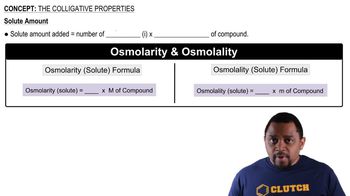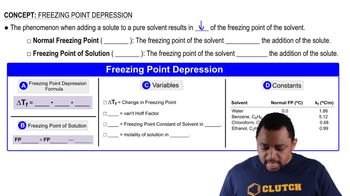Here are the essential concepts you must grasp in order to answer the question correctly.
Colligative Properties
Colligative properties are physical properties of solutions that depend on the number of solute particles in a given amount of solvent, rather than the identity of the solute. These properties include boiling point elevation and freezing point depression, which occur when a solute is added to a solvent, affecting the temperature at which the solvent freezes or boils.
Recommended video:
Freezing Point Depression
Freezing point depression is a colligative property that describes the decrease in the freezing point of a solvent when a solute is dissolved in it. The extent of freezing point depression can be calculated using the formula ΔTf = i * Kf * m, where ΔTf is the change in freezing point, i is the van 't Hoff factor, Kf is the freezing point depression constant of the solvent, and m is the molality of the solution.
Recommended video:
Freezing Point Depression
Boiling Point Elevation
Boiling point elevation is another colligative property that refers to the increase in the boiling point of a solvent when a solute is added. This phenomenon can be quantified using the formula ΔTb = i * Kb * m, where ΔTb is the change in boiling point, i is the van 't Hoff factor, Kb is the boiling point elevation constant of the solvent, and m is the molality of the solution.
Recommended video:





